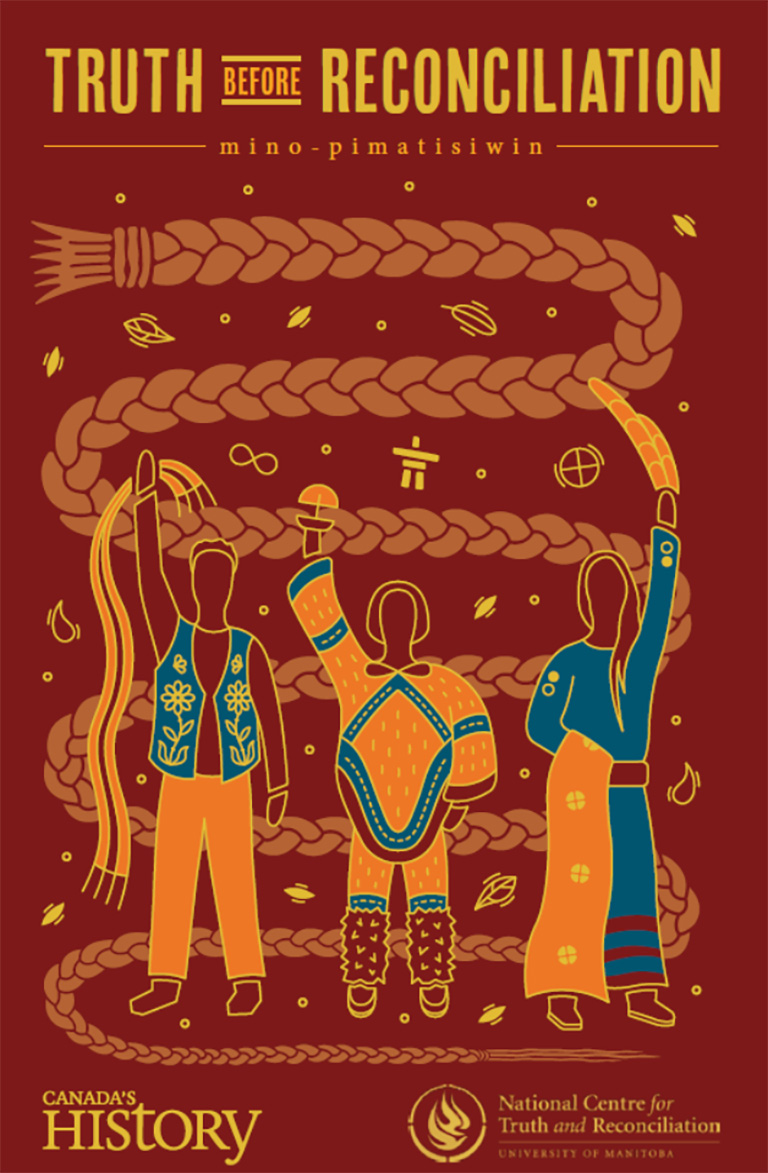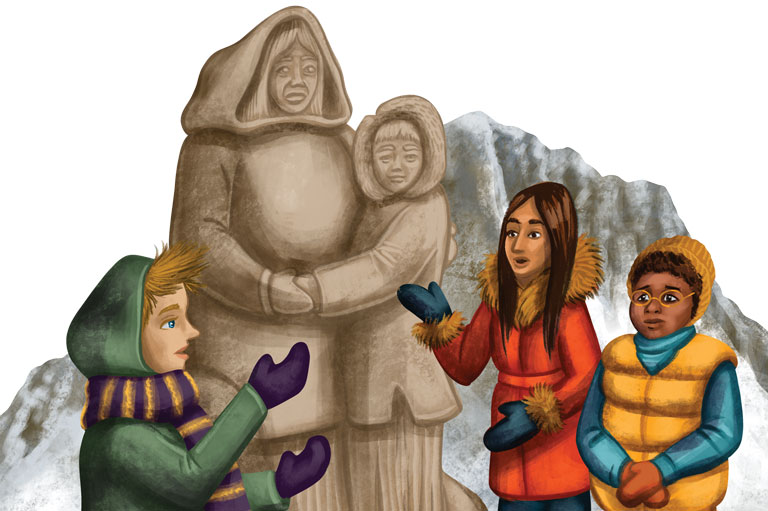This multi-part lesson plan will help students understand the United Nations Declaration on the Rights of Indigenous Peoples (UNDRIP) and explore historical and contemporary injustices against First Nations, Inuit, and Métis Peoples in Canada. Students will engage in activities that encourage them to consider the government’s treatment of Indigenous Peoples, learn about Indigenous-led movements, and take action in support of reconciliation.
Students will:- Understand the responsibilities and rights outlined by the United Nations Declaration on the Rights of Indigenous People (“UNDRIP” or “the Declaration”).
- Learn about historical and contemporary injustices against First Nations, Inuit, and Métis Peoples in Canada.
- Determine whether the Government of Canada treats First Nations, Inuit, and Métis Peoples fairly.
- Question to what extent the Government of Canada has addressed past and/or current injustices against Indigenous Peoples. What have been the results of these efforts?
- Learn about Indigenous-led movements in Canada and how students can participate in them.
Teacher will:- Learn alongside their students and let them lead in participating in matters that concern them.
- Ensure that if they do not know an answer to a question, they do meaningful research and/or speak with their school board’s Indigenous Education Team or other experienced and knowledgeable colleagues within their learning community.
- Facilitate conversations in trauma-informed ways and consider holistic teaching pedagogies throughout the instruction of the lesson and those thereafter.
|
The United Nations Declaration on the Rights of Indigenous Peoples (UNDRIP) was adopted by the UN General Assembly on September 13, 2007. UNDRIP is a framework that recognizes the rights of Indigenous Peoples worldwide, including the right to self-determination, cultural preservation, education, health, and land. The Declaration sets out a universal framework for the survival, dignity, and well-being of Indigenous Peoples.
In its 2015 report, the Truth and Reconciliation Commission centred the Declaration in the 10 Principles of Reconciliation, calling UNDRIP, “the framework for reconciliation at all levels and across all sectors of society.”
The Government of Canada initially opposed the Declaration but eventually endorsed it in 2010 as an aspirational document. In 2016, the Government of Canada announced its full support for the Declaration and committed to its implementation. In 2021, the Government of Canada passed Bill C-15, the United Nations Declaration on the Rights of Indigenous Peoples Act, which began the process of ensuring Canadian laws and policies are aligned with the principles of UNDRIP. However, the implementation of UNDRIP in Canada remains a complex and ongoing process. |
PART IThis lesson introduces students to human rights and the United Nations Declaration on the Rights of Indigenous Peoples (UNDRIP). Students will research and learn more about the rights that this international agreement protects.- Share this definition of human rights with your students: Human rights are the rights and freedoms that all people have. They can be considered rules for how we should treat one another. Human rights help keep people safe and help make sure everyone is treated fairly.
- Explain to students that while human rights have always existed, they have not always been protected. However, since the Second World War, important laws and international agreements have been created to protect human rights. In addition to the Universal Declaration of Human Rights of 1948 (UDHR), there is also the 1990 United Nations Convention on the Rights of the Child (UNCNC) and the 2007 United Nations Declaration on the Rights of Indigenous Peoples (UNDRIP).
Have students read about UNDRIP on pages 18-19 of Mino-pimatisiwin: Living the Good Life.- Begin a conversation with students to have them develop an understanding of how they can honour what is outlined in UNDRIP. Share some of the articles protected under UNDRIP — we have suggested some you can use in Appendix II, but you can expand or condense this list based on your classroom.
- For each UNDRIP article, share what it means and brainstorm with your students some examples of that right being upheld in Canada. You can make this conversation engaging by co-creating a concept map of the different rights they learn about, examples of what those rights mean, and including definitions of words that may be new.
PART IIIn this lesson, students will come to understand that First Nations, Inuit, and Métis Peoples’ rights have not always been respected and honoured in Canada. They will learn about some past and contemporary examples of unfair treatment towards First Nations, Inuit, and Métis Peoples. They will also learn about role models who have worked hard to enact and uphold Indigenous rights in Canada.- Have students look at their concept maps and remind them of what they have learned about human rights.
- Introduce the idea that First Nations, Inuit, and Métis Peoples’ rights have not always been upheld in Canada. Individually or as a class, have students read pages 11 and 16 of Mino-pimatisiwin: Living the Good Life, which provide some examples of moments when rights were not protected and also of efforts that have since taken place to ensure that rights are protected.
- Discuss with students historical and contemporary violations of Indigenous Peoples’ rights in Canada. This can include examples from Mino-pimatisiwin: Living the Good Life or others that they have previously learned about or actively researched for this activity. Have students connect each issue to a specific article of UNDRIP.
- Initiate a conversation with students about the historical significance of UNDRIP. You may wish to do some additional research with your students to explore one of the following questions:
- Why was UNDRIP necessary for Indigenous Peoples globally and in Canada?
- Why did Canada initially reject UNDRIP? What events or influences had the biggest impact on the federal government’s decision to adopt the Declaration?
- What articles do you think will make the biggest impact on First Nations, Inuit, and Métis Peoples’ rights in Canada?
PART IIIIn this lesson, students will discover movements that work to uphold the rights of Indigenous children and consider how they can act against various forms of discrimination. - Let students know that despite there being past and current examples of Indigenous Peoples’ rights being violated, there are also lots of individuals and groups who are speaking out against injustices and working to make change. Students can discover some of these role models throughout Mino-pimatisiwin: Living the Good Life.
- Play all of the following videos for your students to learn about the ways that others are taking action in Canada:
As noted in this guide’s introduction, some of the videos share big discussion topics, so ensure that Indigenous students in your class are supported. Consult with the Indigenous Education Team at your school board on how to do this in a good way.
After showing each video to your students, lead a whole-class discussion. You may explore the following questions. Some may require additional research to answer:- What is the movement about? What right is being protected? Who is involved? What is their message? How does it make you feel?
- How does this issue highlight the unfair treatment of First Nations, Inuit, and Métis Peoples in Canada?
- How have the different levels of government responded to the movements? Have their actions been sufficient?
- How can individuals make a difference toward ending discrimination against First Nations, Inuit, and Métis Peoples in Canada?
End the conversation by highlighting the key takeaways from your collective conversation.- After learning about specific examples of movements in Canada, ask your students to create a list of the different ways that people can take action by asking, “What does taking action look like?” Answers may include:
- Listening to speeches, attending presentations or hearing testimonies
- Educating others; sharing their learnings with their friends, family, and school community
- Attending Indigenous cultural events or visiting Indigenous-run museums
- Participating in movements (online or in-person), phoning or writing letters to elected officials/decision-makers in Canada and the world
- Donating to Indigenous charities or organizations
- Ask students to consider which actions have the most impact and are the most meaningful. Which actions are considered more passive and require less engagement? Why? Have students create class-based criteria for assessing these actions and rank them from least effective to most effective.
PART IVNow that the students know more about UNDRIP and the rights of Indigenous Peoples in Canada, they can practice participating in matters that concern them. You may continue to explore the youth movements introduced earlier or investigate other issues that are pressing in Canada such as (but not limited to) land disputes, resource extraction, Indigenous children in care, or language revitalization.
To begin, read aloud the message from Elder Harry Bone and Elder Florence Paynter on pages 4-5 of Mino-pimatisiwin: Living the Good Life. Through this message, the Elders have shared an important teaching. Have students reflect on the meaning of Mino-pimatisiwinand how they can follow a good path in taking action toward reconciliation in Canada.- Ask your students to form groups of three or four and select a movement from those discussed in which they would like to participate. Multiple groups can work towards the same movement, honouring Mino-pimatisiwin.
- Have students decide which articles from UNDRIP will be honoured as they respond to their selected movement. (Encourage students to limit their selection to five articles — we can’t respond to everything as much as we want to!)
- Now that the students have selected the relevant articles, it is time for them to research each of their movements. Students will be encouraged to respond to the following questions in their research:
- What is the issue about? What is the historical context for the issue?
- What is the movement about?
- Who are the leaders in the movement? Is there youth participation?
- Who are the individuals, organizations, or governments that are responsible for this issue?
- What are ways everyone living in Canada can make a difference and take action toward this movement?
- What are the ways we have chosen to participate in the movement?
- After the students answer the questions from their research, they can now mobilize what they have learned! There are lots of ways students can apply what they have learned, such as creating a podcast or video, making a public service announcement, creating a letter template for others to complete and send to their elected officials/decision-makers, making posters for their school or community, performing a song, or writing a report to share with their peers or to send to influential groups. You may also use the template in Appendix III to create a social media campaign.
- Each campaign should include the following elements:
- Introduction to the issue, including specific information, historical context, and compelling data or statistics
- A connection to the relevant articles of UNDRIP
- A clear message about how people can get involved and make a difference toward reconciliation
- How they are honouring the concept of Mino-pimatisiwin in their efforts, and how they will plan to honour Mino-pimatisiwin every day
|







